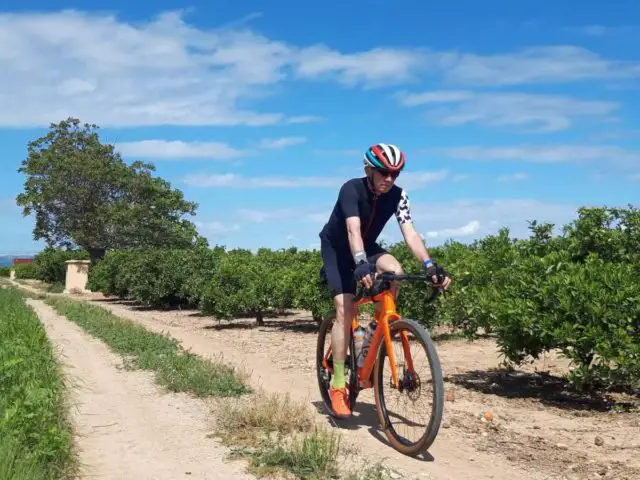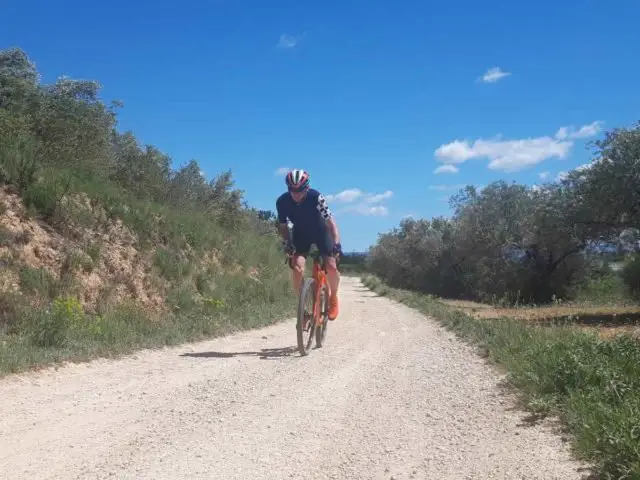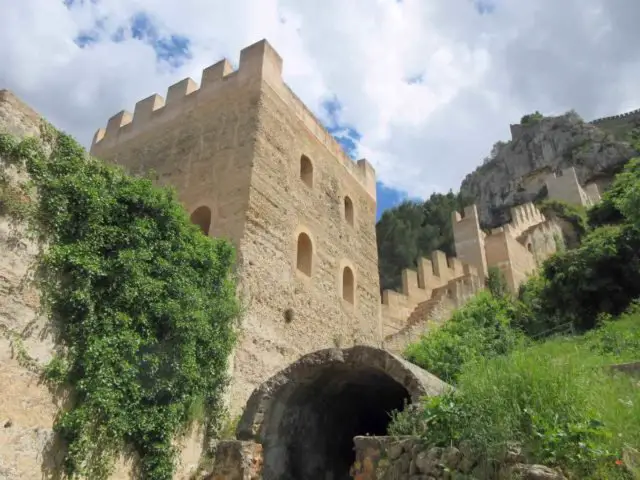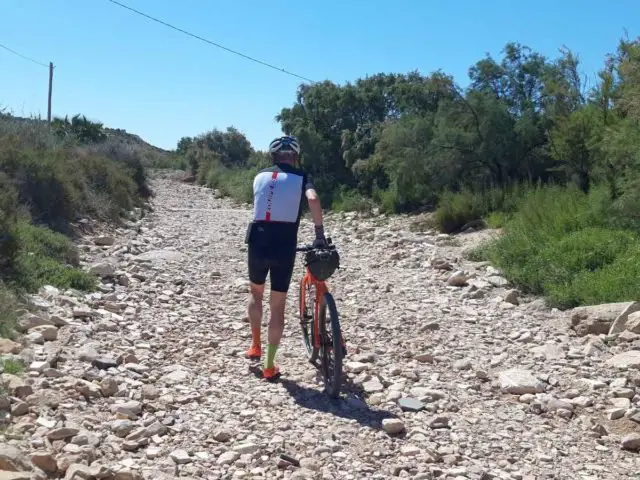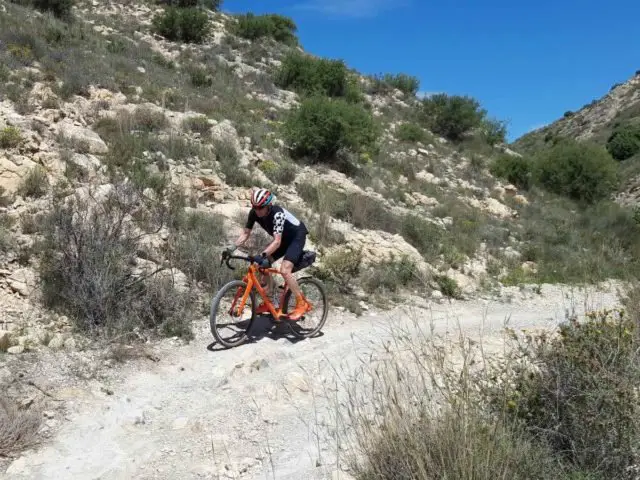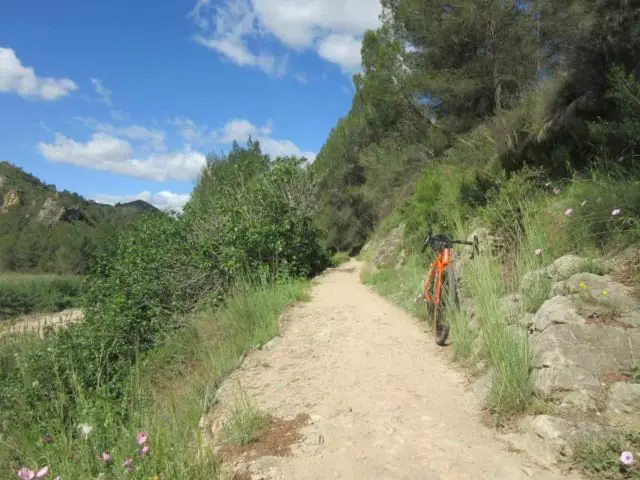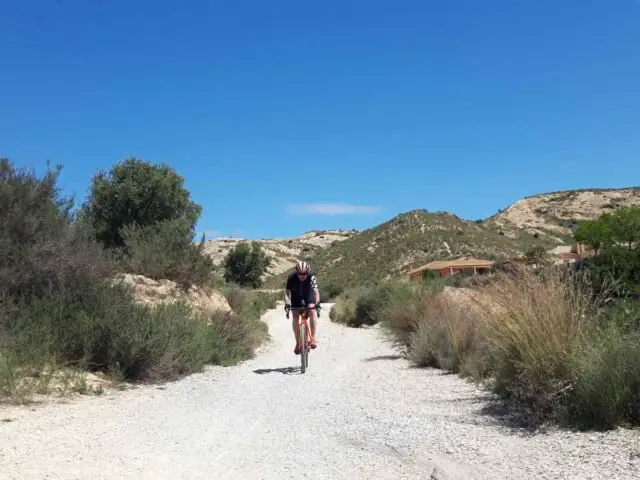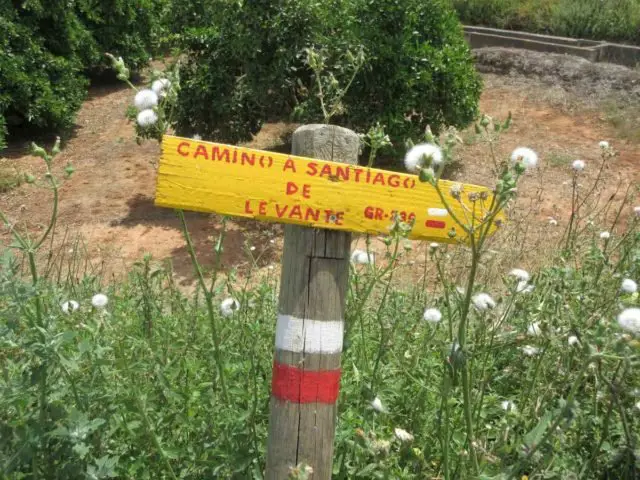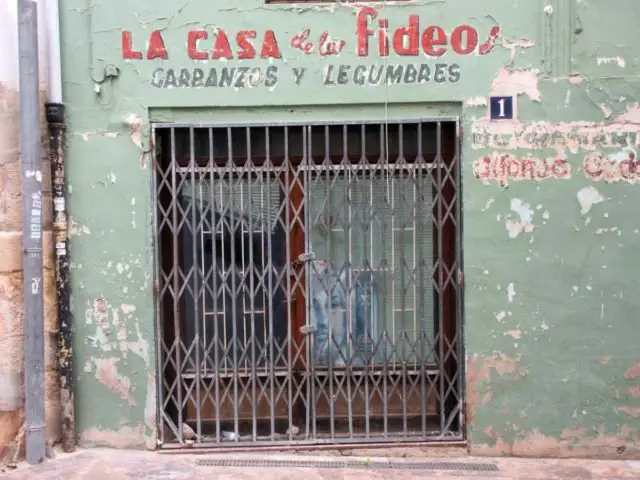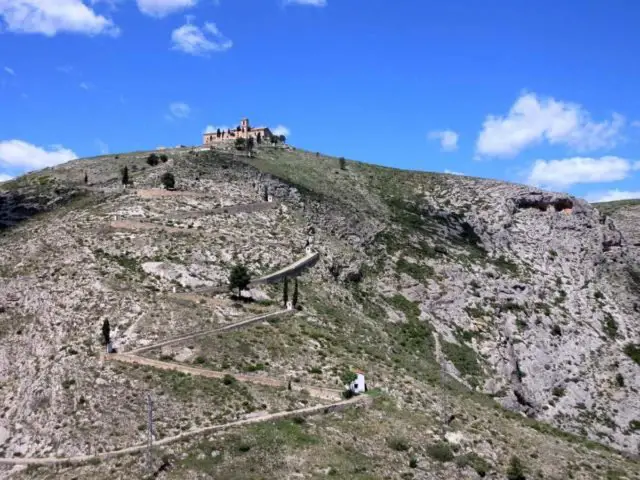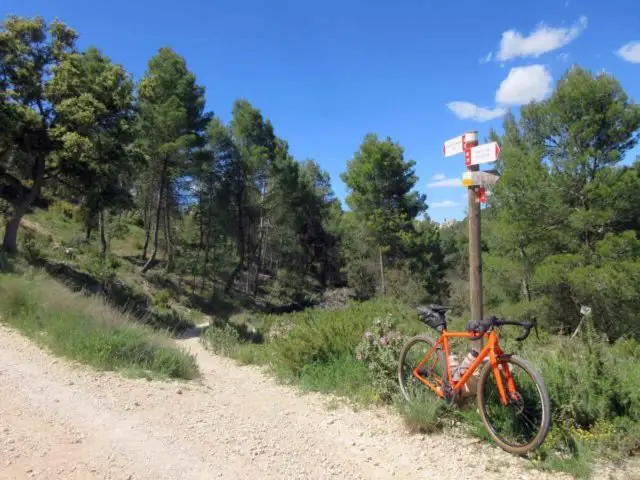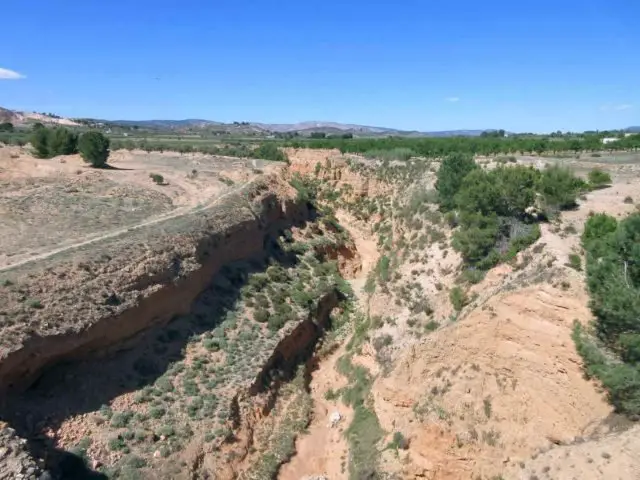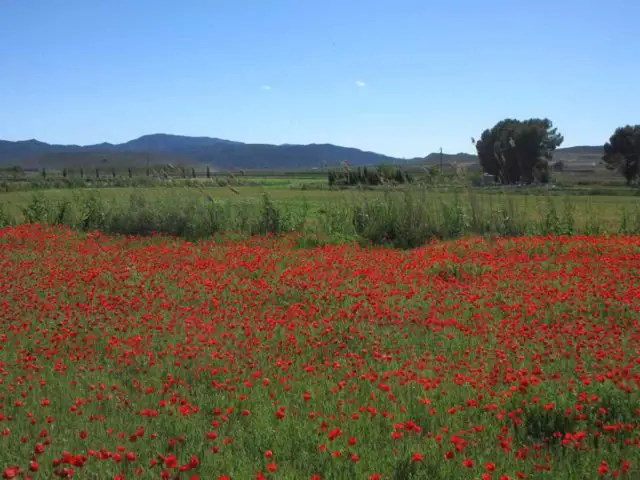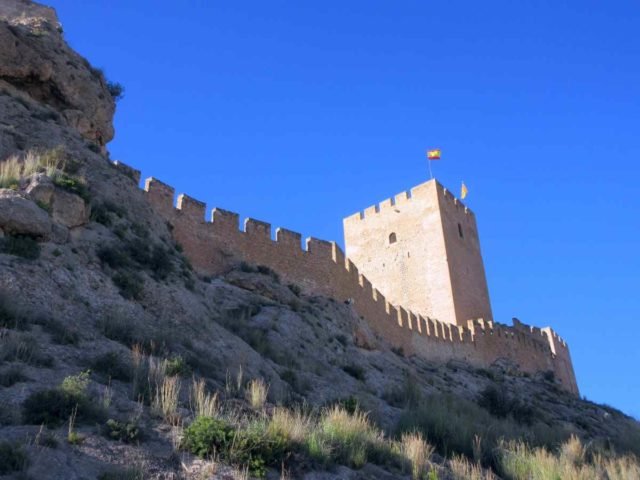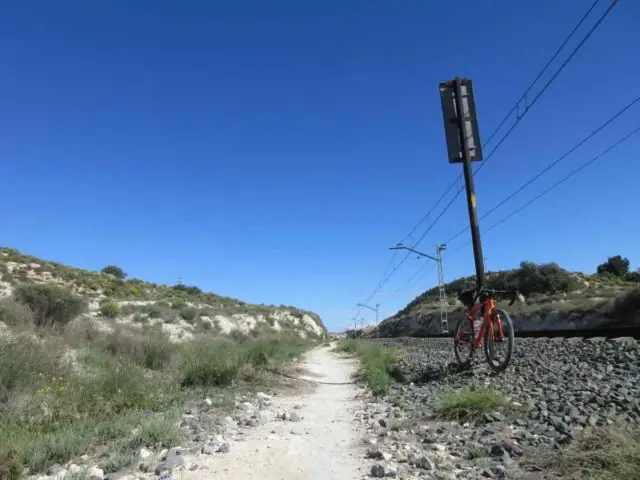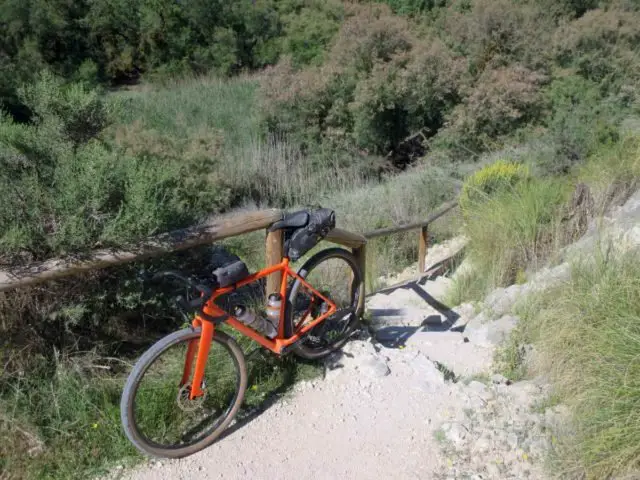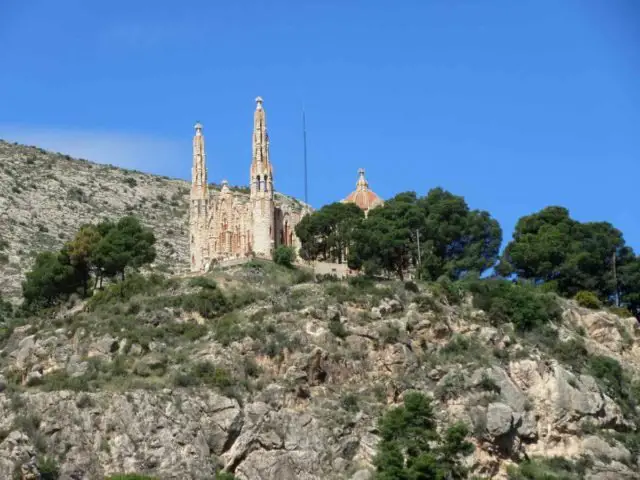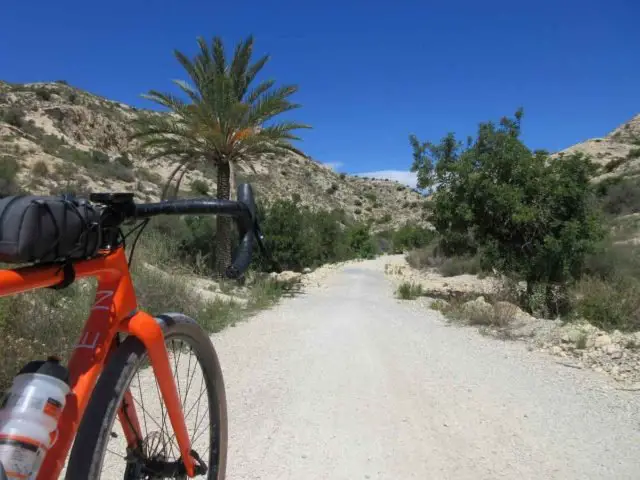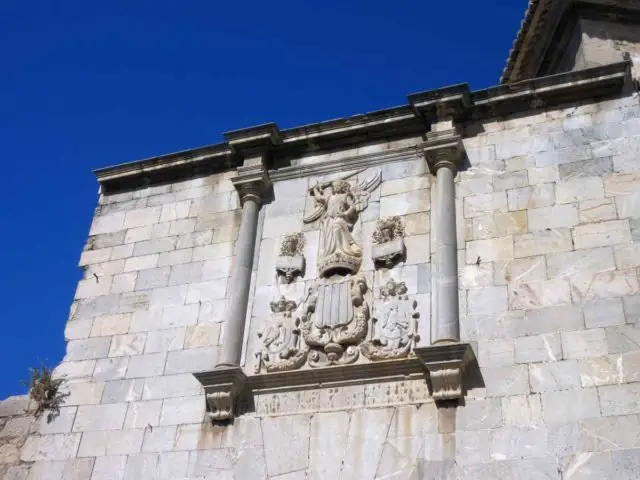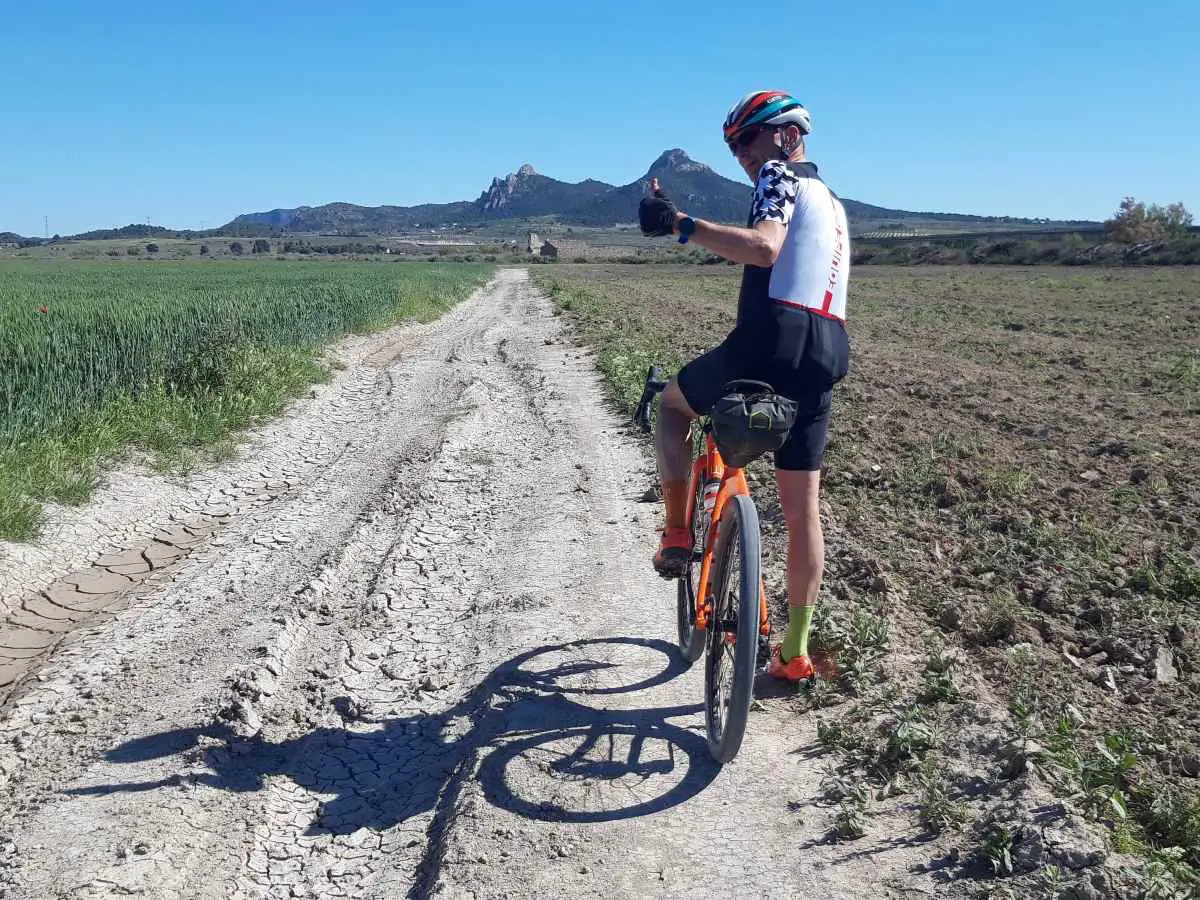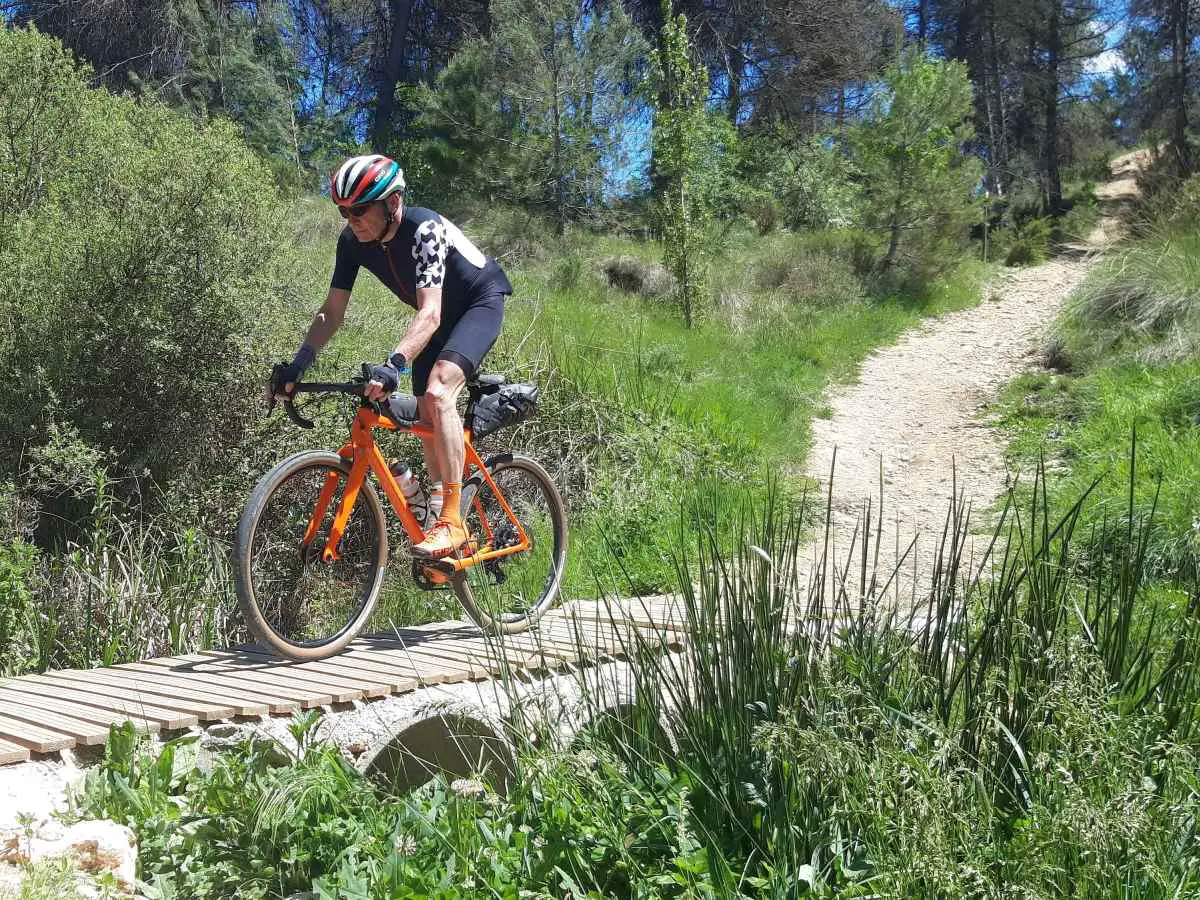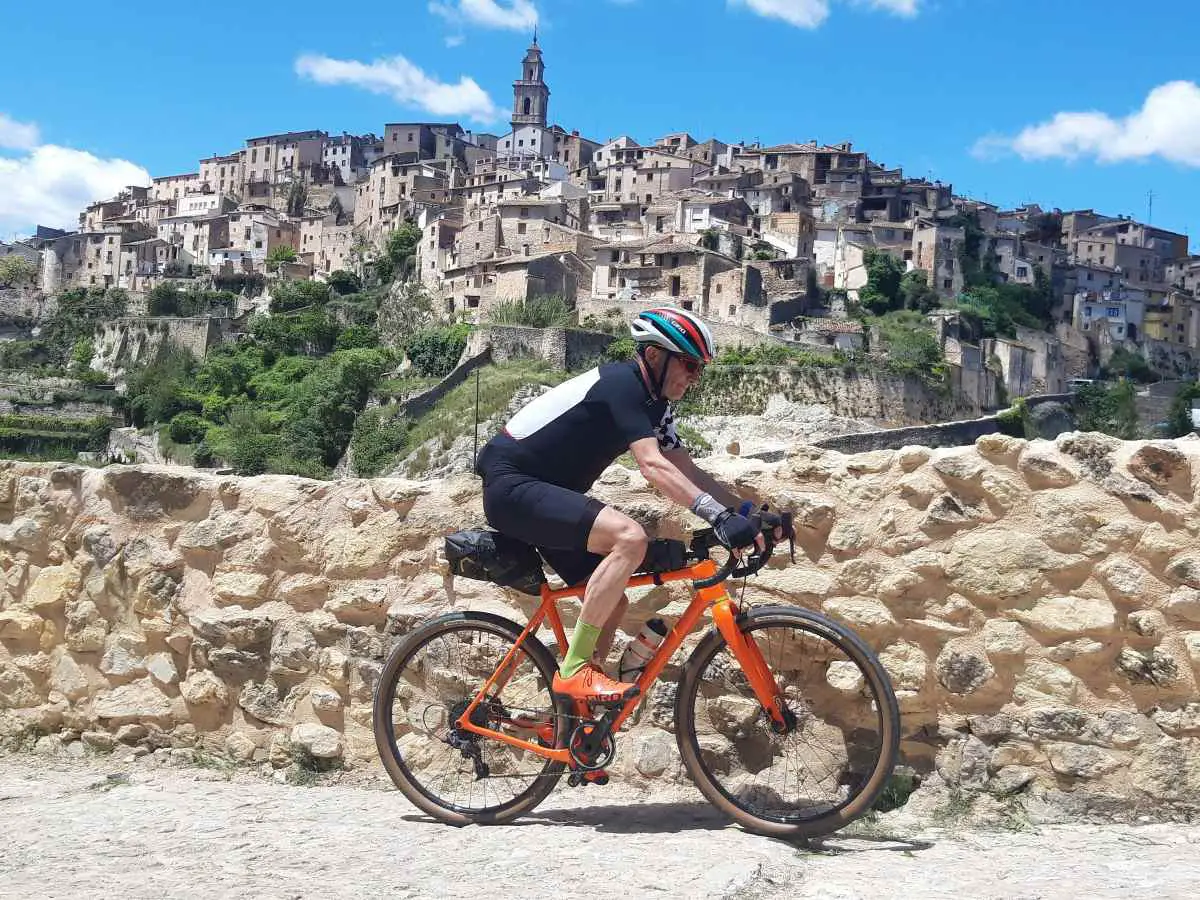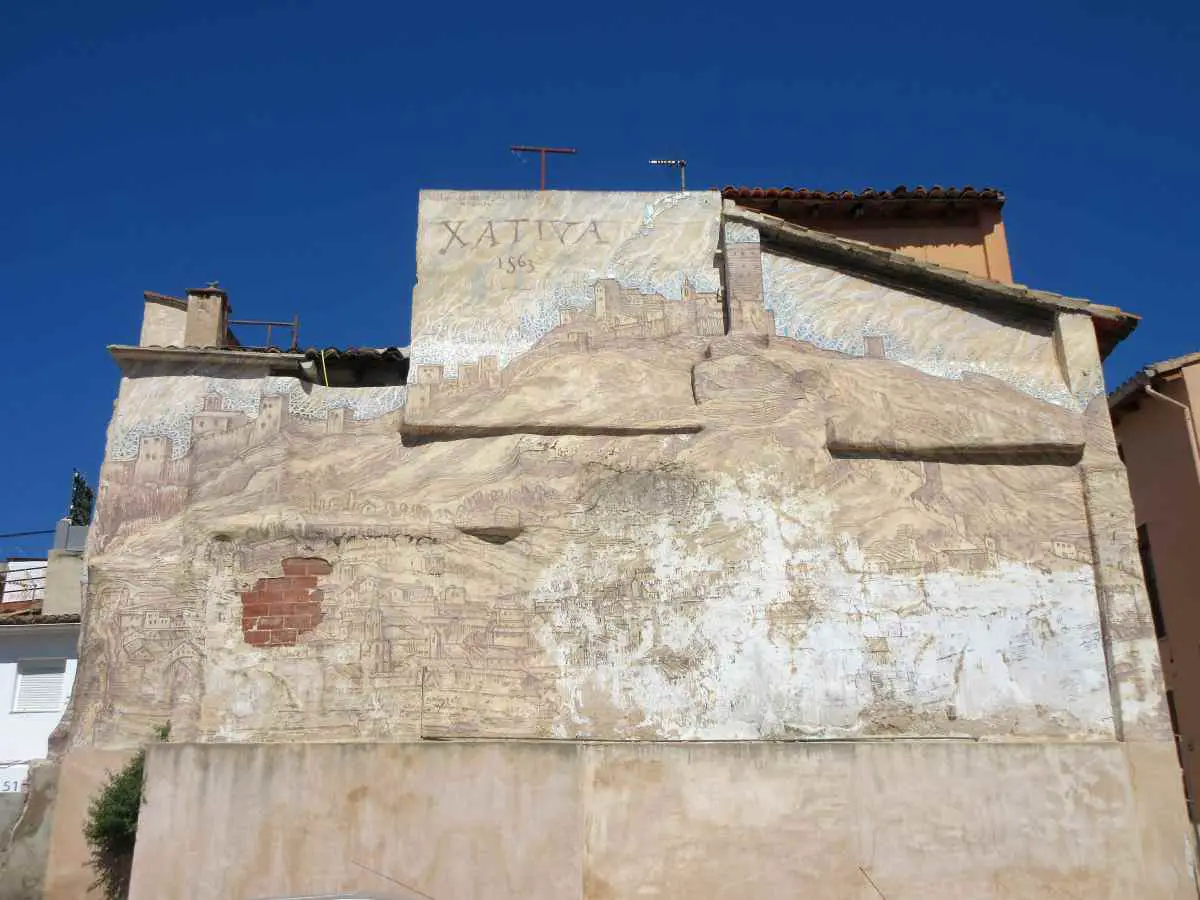In 2019 we had to end our gravel tour in the footsteps of “El Cid” because of the terrible storm in Valencia. In 2020 we could not travel to Spain because of the Coronavirus pandemic. But in spring 2021 the time had come – traveling on the Iberian Peninsula was possible again and so we went on our third and last trip in the footsteps of “El Cid” in mid-May. You can see the other parts of my El Cid adventure, HERE, HERE, and HERE.
The last section, which leads south from Valencia, is called “Defending the South” and touches again on the historical points from the story “El Cantar del Cid”.
We follow the track starting at the “El Cid” monument in Valencia in a southward direction. Huge orange groves accompany us on the first few kilometers. Gravel slopes constantly alternate with small asphalt roads. The places we cross have Arabic-sounding names such as Alzira or Almussafes. Our first stage destination is the small town of Xativa, above which an impressive castle with huge walls towers.
Near Xatifa it goes up very steeply on a dilapidated road before we reach a narrow single trail on a river. The seclusion ends in Ontinyent. After the small town, we will relax by a picturesque river. The historic town of Bocairent, which we then reach, is as if painted on a mountain and the approach over the bumpy bridge “Darrere la Vila” is an experience.
After Banyeres de Mariola it gets very exhausting. We push and carry the bikes on a path with large stones on a plateau. We cross the “Sierra de la Fontanella” on dreamy wide slopes before it goes steeply downhill to Biar. This small village is also dominated by an old castle that is well worth seeing. Then you continue on an old railway line, which is called “Via Verdes” in Spain. With a tailwind and on stuck dirt roads we reach Sax. After a long shower, we walk up to the Castillo and enjoy the sunset, which bathes the barren landscape in a reddish light.
Our last stage leads along a railway line. Later we follow the “Rio Vinalopo” on beautiful slopes. The track is sometimes very stony – but we have a lot of driving fun. After a huge golf course we drive through a “Rambla”. There are huge palm trees here and we feel like we are in Africa.
After Elda, where we take a well-deserved break, we make it flatter and even more secluded. At an old train station, we take a short coffee break in a small Spanish bar. Here we meet Viktor + Jose, who are redesigning the route of the “Camino del Cid”.
The landscape is getting lonelier and drier. Huge lemon groves accompany us on the way to our destination in Orihuela. After more than 250 exhausting kilometers on wonderful gravel slopes with historic old villages and castles, we are at our destination on the third day of our journey. Here a journey with the story of “El Cid” finally comes to an end. The third part of our gravel adventure was a mixture of the USA, Mexico, and North Africa. Every gravel cyclist should undertake a trip on a gravel bike in the footsteps of “El Cid”.
The Plot: A Historical and Literary Route along the Inland Defence Line
Unlike the previous routes, along the southern defense line – La Defensa del Sur – history takes precedence over literature. The author of The Poem of the Cid was unable to come up with arguments strong enough to merge into a single plot the two periods of exile to which, according to history, El Cid was condemned by Alphonse VI. The first was in Castile, in 1081, and the second, far harsher and more significant, in 1088, during the time El Cid spent in Alicante. This route retraces this historic episode, together with a number of others related to the threat from the south of the Almoravid dynasty.
Great is the rejoicing there/ when mio Cid took Valencia and entered the city / Men who had been on foot made it into the city on horseback / and as for the gold and silver, who could count it? The conquest of Valencia by El Cid was the culmination of a dream yet also the origin of serious concerns surrounding the need to defend the city, which would withstand the Almoravid onslaught until 1102, the year when Jimena – El Cid had died three years previously – left the city.
According to the Poem, El Cid finally managed to enter Valencia after a long and drawn-out siege. The King of Seville attempted to regain the city but was defeated in a battle fought out in the Huerta de Valencia region. It is then that El Cid was pardoned by Alphonse VI; his wife and daughters travelled to Valencia and El Cid would show them the extent of his domains from the fortress tower. The Almoravid King Yusuf would later march on the city with 50,000, but they were also repelled. Following this victory, El Cid married his daughters to the Infantes of Carrión. Two years later, King Bucar laid siege to Valencia, setting up a camp with 50,000 tents. He was defeated and slain by El Cid, who seized his sword, known as Tizona, worth a thousand gold coins. Finally, after recovering his honour and being proclaimed a great lord and warrior, El Cid died in Valencia.
Although this is the story narrated in the Poem, history has a very different tale to tell. Generally speaking, most of the towns in the south of Valencia sided with the powerful Almoravids, who had set up their military base in Murcia. There is historical evidence that during the siege of Valencia, an Almoravid army camped in Almussafes but was forced to retreat following torrential flooding. In 1093 El Cid attacked the city of Alzira, which had refused to support him. He ordered the harvesting of the local crops which were then taken to his general headquarters in El Puig and in 1097 a contingent of his men were defeated in Alzira by an Almoravid expedition.
During the later years of Rodrigo’s life, even Xàtiva, which had initially yielded to the might and power of El Cid, became the spearhead for the Almoravid offensive against Valencia. Indeed, the Poem of The Cid relates that it was there that the Moorish King of Seville sought shelter there whilst fleeing from Rodrigo.
The second reason for this route is historical, and starts some 25 km from Xàtiva, in Ontinyent. In November 1088 El Cid travelled from Xàtiva to Ontinyent to await the arrival of King Alphonse VI, who was on his way to assist Aledo. The king asked Rodrigo to wait for him in Villena, but he chose Ontinyent instead because there he could be sure of sufficient provisions for his men. The meeting between the two forces never took place, and El Cid set up camp in Elche where he spent the Christmas period. It was there that he heard the news that Alphonse VI had declared him a traitor, once again casting him into exile. In the midst of enemy territory, he vowed never again to serve any master, and to act only in accordance with his own free will.
The route ends in Orihuela. The connection with Orihuela dates back to 1090. After defeating the Catalonian Count Berenguer Ramón II at the Battle of Tévar, El Cid set up a vast protectorate of the Moorish kingdom of Al Hayib, which included the territories of Lerida, Tortosa, and Denia. According to Ben Alcamo, by 1091 this protectorate extended from Tortosa to Orihuela.
The Journey
La Defensa del Sur is a route of sharp contrasts: from well-developed stretches made up mainly of farm tracks and vías verdes – reconditioned railway tracks – to trails leading through the more mountainous areas. On leaving Valencia and its surroundings, travellers will come across two of this region’s greatest landmarks: La Albufera and the Huerta de Valencia.
La Albufera is a coastal lagoon of shallow waters – with an average depth of just one metre, set amidst rice fields and enclosed from the sea by a sand bank created by the sea currents. It has been exploited by Man since ancient times and today is home to a considerable number of animal and plant species: from water birds to fish in danger of extinction, such as the Spanish and Valencia toothcarp.
The second of the most striking features of this area is the ‘Huerta de Valencia’ – literally ‘the Orchard of Valencia’-: a unique natural, social and economic space that is deeply rooted in the region’s history. Back in the 11th century, the virtues of Valencia’s vegetable and fruit orchards, so highly prized by the Moors, were sung by the poet Ibn Jafaya, who was born in Alzira. Indeed, the Moorish defence walls of this town, remind us of its origins. Alzira is one of the eight towns along the route that have been declared historic and/or artistic sites.
The next is Xàtiva, which boasts a magnificent historic and artistic heritage, the highlight of which is its castle. Together with Sax Castle, it is one of the most magnificent sights to be admired on this route.
From Ontinyent we start the climb up to Bocairent amidst a Mediterranean mountain landscape lined by sheer precipices and the Pou Clar well, where we recommend a refreshing dip – and the Mariola Mountain Range. The climb passes through spectacular scenery but includes a number of challenging stretches that will force cyclists off their bicycles. However, their efforts will be amply rewarded on reaching Bocairent, a city carved out of stone and one of the greatest surprises this route conceals.
The Way of El Cid enters the province of Alicante via Banyeres de Mariola. Its castle is the first on a defense line dating back to the days of the Almohads and which passes through Biar, Villena, Sax, and Petrer before finally reaching Elche. The line boasts a wealth of medieval heritage including the Palmeral or Palm Grove, a World Heritage Site. From Elche we make our way down to Bajo Vinalopó. The arid landscape forms a stark backdrop for the fertile farming lands and palm groves dotted along the way. This is a densely populated area that ends in what has come to symbolise the southern extreme of El Cid’s domains: the monumental town of Orihuela.
Culinary Delights
Although rice is the hallmark of Valencia’s cuisine, with a wide range of varieties and a host of different dishes prepared in multiple ways (paella, a banda – cooked in stock -, creamed, in squid ink, in desserts, etc.), this is also a land characterised by its gastronomic intensity and diversity. For instance, Valencia’s vegetable and fruit orchards have been renowned since the days of the Moors, resulting in a long list of mouth-watering dishes, such as pericana – an intensely flavoured sauce made from poor cod, olive oil and sun-dried peppers – and fish, freshly caught off the coast. After all, this is the Mediterranean.
Travellers will also have the chance to taste a different kind of cuisine, characteristic of this land, such as the guisos de los marjales or eel stews, or the puchero valenciano which, unlike the stews and casseroles of Castile, is lighter and contains less fat. The inland and mountain areas of Alicante are the perfect choice for enjoying a dish traditionally eaten by shepherds and that when properly prepared is absolutely delicious: Alicante gazpacho, made with meat, normally hare or partridge seasoned with local herbs and served with flour flatbread.
When it comes to sweets and desserts, and without forgetting the famous citrus fruits and horchatas – tiger nut milk drinks – it must be remembered that these lands are home to turrón nougat. Alicante’s nougat is famed throughout the world, but both Valencia and Alicante produce delicious almond nougats made from traditional recipes.
The Track
https://en.caminodelcid.org/routes/defending-the-south-btt—mtb-553518/


